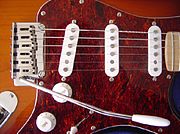
Electric guitars can have solid, semi-hollow, or hollow bodies, and produce little sound without amplification. Electromagnetic pickups convert the vibration of the steel strings into electrical signals which are fed to an amplifier through a cable or radio transmitter. The sound is frequently modified by other electronic devices or the natural distortion of valves (vacuum tubes) in the amplifier. There are two main types of pickup: single coil and double coil (known as humbuckers), each of which can be passive or active. The electric guitar is used extensively in jazz, blues and rock and roll, and was commercialized by Gibson together with Les Paul and independently by Leo Fender of Fender Music. The lower fretboard action (the height of the strings from the fingerboard) and its electrical amplification lend the electric guitar to some techniques which are less frequently used on acoustic guitars. These techniques include tapping, extensive use of legato through pull-offs and hammer-ons (also known as slurs), pinch harmonics, volume swells and use of a tremolo arm or effects pedals.
Seven-string solid body electric guitars were popularized in the 1980s and 1990s in part due to the release of the Ibanez Universe guitar, endorsed by Steve Vai. Other artists go a step further, by using an 8 string guitar with two extra low strings. Although the most common 7 string has a low B string, Roger McGuinn (Of Byrds/Rickenbacker Fame) uses an octave G string paired with the regular G string as on a 12 string guitar, allowing him to incorporate chiming 12 string elements in standard 6 string playing.
The electric bass guitar is similar in tuning to the traditional double bass viol. Hybrids of acoustic and electric guitars are also common. There are also more exotic varieties, such as guitars with two, three[11] or rarely four necks, all manner of alternate string arrangements, fretless fingerboards (used almost exclusively on bass guitars, meant to emulate the sound of a stand-up bass), 5.1 surround guitar, and such.
Some electric guitar and electric bass guitar models feature Piezoelectric pickups, which function as transducers to provide a sound closer to that of an acoustic guitar with the flip of a switch or knob, rather than switching guitars.